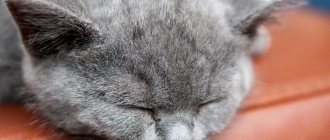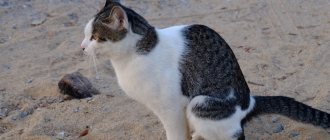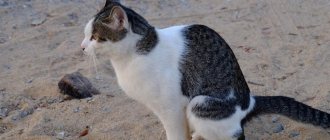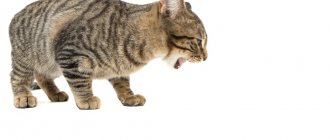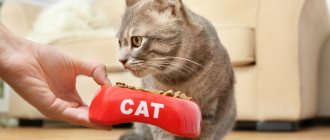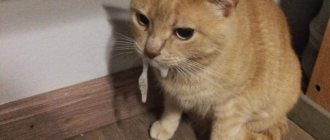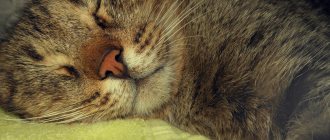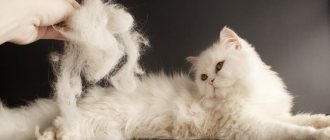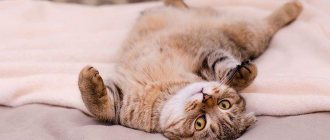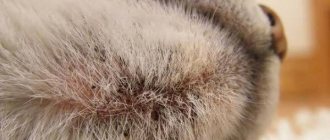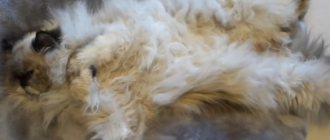Diagnostic methods
A thorough examination is required to make a diagnosis and prescribe therapy. First of all, the doctor must find out from the cat’s owners when and under what circumstances the changes began. The diet, previous diseases and features of the clinical picture are refined. After a general examination and temperature measurement, the following diagnostic methods are used in veterinary medicine:
- Analyzes. The cat's blood, urine and feces are taken for examination. The test results allow us to determine the general condition of the furry, the presence of parasites, liver and gallbladder diseases, and poisoning.
- Coagulogram. A study to determine the rate of blood clotting.
- Gastroscopy. Makes it possible to see the true condition of the inner walls of the stomach, detect ulcers or erosion, foreign bodies.
- Ultrasound of the peritoneum. Allows you to determine the presence of neoplasms and cysts, stones or sand in the gallbladder, and intestinal obstruction.
- Radiography. Detects liver enlargement and the presence of tumors.
- Biopsy. If a tumor is detected, the affected tissue is collected for analysis. Against the background of black feces and the accompanying clinic, the liver often suffers.
General examination Clinical examination Ultrasound of the peritoneum
Diarrhea symptoms
If the color of the bowel movements deviates from the norm, and your pet is losing a lot of hair, you should consult a specialist.
Cat feces that differ from the norm in color and consistency are already a pathological sign, indicating that not everything is in order with the pet’s body. Other symptoms that require immediate action:
- violation of general condition;
- nausea accompanied by vomiting;
- weakness, drowsiness, apathy;
- increased gas formation;
- persistent constipation or, conversely, diarrhea;
- increased body temperature;
- abdominal pain on palpation;
- blanching or yellowing of the mucous membrane;
- dullness and excessive hair loss;
- lack of appetite;
- rapid weight loss.
Regardless of the etiology (i.e. origin) of diarrhea, all its types can be divided into two large types:
- Acute diarrhea.
- Chronic diarrhea.
Accordingly, the symptoms of these two varieties will differ significantly.
In this case, everything is quite simple and clear. First, you need to decide on the terminology: “acute” diarrhea is called in cases where it began suddenly and lasts no more than two days, accompanied by a significant deterioration in the condition of the sick animal.
The following signs of such diarrhea are distinguished:
Defecation is frequent, the animal constantly runs to the tray.
As a rule, feces are liquid; they often contain impurities in the form of mucus, half-digested pieces of food, and sometimes blood can be seen.
After just five or six trips to the potty, the animal begins to meow hoarsely, constantly licking the anus area.
If diarrhea continues for more than two days, the cat becomes noticeably weaker. In the most severe cases, the pet practically stops grooming itself, its fur becomes matted and becomes covered with a crust of dried feces.
In the same cases, severe blanching of all visible mucous membranes is observed. They become dry and sticky to the touch. The skin loses its elasticity, the coat becomes rough and hard.
The following conclusions can be drawn from all of the above:
If diarrhea lasts less than a day, and the general condition of the animal at this time remains stable and does not cause alarm, you can try to cope with diarrhea on your own.
In cases where a cat suffers from diarrhea for more than a day, and its condition is slowly but deteriorating, you should definitely show the animal to a veterinarian
This precaution will probably not be superfluous.
This type of pathology manifests itself somewhat differently:
Diarrhea occurs sporadically, not every day.
Interestingly, cases of diarrhea may well alternate with periods of “impenetrable” constipation.
The cat’s condition “by eye” remains normal, but this impression is wrong. If nothing is done and the true root cause is not identified, the animal will gradually develop exhaustion.
What to feed a cat with diarrhea
Many owners are concerned about the question of what to feed their cat during and after diarrhea. The first, main rule is a fasting diet in the first day after the onset of diarrhea. This step may seem pointless, but it is important to understand the following:
- During diarrhea, the mucous membranes work more actively and secrete a lot of fluid.
- Food that enters the intestines ends up in a mucous environment and is not digested.
- Due to incomplete fermentation, food does not soften and scratches the intestinal walls.
Simply put, feeding against the background of full-blown diarrhea is a disservice that will only delay recovery. After eliminating the acute condition, the cat should receive a dietary diet for 3–4 days.
If you do not know the exact reasons for the development of the disease, it is better to exclude whole milk from your diet; fermented milk products and cheeses (without salt) are not included in the exception. Feed your pet boiled meat, low-fat broth, cottage cheese and don’t forget about coarse fibers.
White feces in a cat: causes of color change, treatment and prevention
White feces in a cat is a sign of improper functioning of the pancreas, liver or gallbladder. A responsible and attentive owner will never ignore a pathological change in the color of feces in an animal
It is important to identify the cause of light-colored stool in time and begin treatment if the disease is present.
Stool color and consistency in a healthy animal
The appearance of feces allows you to assess the health of a cat, cat or kitten. Normally, feces should be:
- dark brown;
- well formed (into a sausage);
- dense;
- wet.
Feces have a specific, mild odor. If the stool smells strongly, this also indicates problems with digestion.
In animals that eat primarily meat, the color of their stool is deep brown. When your pet's diet is dominated by dairy products, the feces will turn light brown or yellow.
If a cat, cat or kitten has white stool, this indicates the development of the disease. The owner needs to observe the animal for several days. If the stool continues to be an unnatural color, you need to reconsider your pet's diet or consult a veterinarian.
Causes of changes in stool color
White or light-colored cat feces warns of the possible presence of a dangerous pathology in the animal’s body. At the same time, the frequency and nature of bowel movements may change.
In the small intestine, feces are colored brown by bile. If the secretion of this physiological fluid is impaired, then the stool is light in color.
Veterinarians identify the following causes of white stool in cats:
- Cholelithiasis. It is a consequence of feeding your pet low-quality, cheap food. Along with it, urolithiasis is often detected. The bile ducts become clogged with sand and stones. Bile continues to be produced, but cannot leave the gallbladder. This can lead not only to digestive disorders, but also to organ rupture.
- Neoplasms in the liver, gall bladder and ducts. Cysts, benign or malignant tumors often cause disruption of the outflow of bile.
- Cirrhosis. Liver cells begin to degenerate. The pathological process is irreversible. With the help of timely therapy, you can prolong and make your pet’s life easier.
- Atony of the gallbladder. The walls of the organ are weak, stretched and soft. They do not contract and do not push bile into the ducts. This may result in organ rupture.
- Deformation of the ducts. The pathology can be congenital and affect the appearance of stool.
- Inflammatory processes in the liver. Most often they are observed with hepatitis and cholangitis.
If the animal has white feces only once, the reason may be due to diet. This happens when there is an excess of phosphorus in the body. Light-colored feces are normal after a pet has eaten a lot of fish (especially river fish). However, the owner must understand that this type of diet is unacceptable for an obligate predator.
Treatment and prevention
The therapeutic course depends on the cause of the change in the color of feces. If an alarming symptom is detected, it is necessary to show the animal to a doctor. To make a diagnosis, the veterinarian will comprehensively examine the cat.
Diagnostics includes:
- external examination of the pet;
- taking blood, stool and urine tests;
- performing an ultrasound, MRI or CT scan of the abdominal organs;
- radiography;
- biopsy of pathologically changed tissues.
The doctor decides what to do and how to treat the animal.
If there are neoplasms, stones in the gall bladder or rupture of an organ, the animal undergoes urgent surgery. If sand is present, a therapeutic diet and diuretics are prescribed.
To eliminate inflammation, the veterinarian prescribes antibiotics, antiviral and anti-inflammatory drugs, as well as immunomodulators for the pet.
It is important that the animal consumes plenty of fluids throughout treatment.
The owner’s task is to ensure proper maintenance and care.
Particular attention should be paid to nutrition. The diet is prescribed by the doctor
The diet should consist of medicinal feed or natural products (fresh meat, liver, stomachs, lungs, vegetables, a small amount of cereals). The pet should not be fed human food (fried meat, sausages, fish, soup, borscht, etc.).
Treatment and prevention of pathologies of the liver, pancreas and gall bladder are closely related. To avoid relapses, your pet must be regularly brought for veterinary examination, given all vaccinations and provided with a balanced diet (high-quality industrial feed or natural products).
Causes of diarrhea in cats
Before taking any measures and using medications, it is necessary to find out the reasons why the cat began to have diarrhea. Experience shows that in 90% of cases, severe disruption of the gastrointestinal tract is associated with the rapid proliferation of pathogenic microflora.
Many owners are accustomed to thinking that if a cat has diarrhea, it means it has eaten something missing or unsuitable. In fact, diarrhea does not have “harmless” causes as often as we would like.
Tip: Monitor your pet closely for changes in condition if he or she develops diarrhea.
If you have one-time diarrhea and the problem is eliminated without intervention, you can consider yourself and your pet lucky. However, you should not relax; take your pet to the veterinarian for examination for dysbiosis, food allergies, vitamin deficiency and other hidden causes of gastrointestinal dysfunction.
Diarrhea due to poisoning
According to owners, most often, diarrhea occurs in pets due to poisoning. This is partly true, but poisoning can be of varying degrees and occur for a number of reasons:
- Food poisoning, for example, expired, spoiled, contaminated food.
- Poisoning with rat or other poisons.
- Poisoning with medications when used in the wrong dose.
- Poisoning by contact poisons and gases.
As you can imagine, this list goes on. However, the same type of symptoms of intoxication are diarrhea and vomiting. Providing assistance in case of poisoning directly depends on the source of the toxins. If the source was eaten, that is, swallowed, the cat is prescribed adsorbents. When toxins enter the blood, the sorbents operating in the intestines are powerless, so the animal is prescribed complex therapy, including blood cleansing.
Diarrhea due to dysbacteriosis
Until recently, it was believed that dysbiosis could not occur in carnivorous animals. Numerous studies have shown the obvious truth - any living creature suffers if friendly microflora in its intestines are replaced by pathogenic ones. Statistics show that dysbiosis is the most common cause of frequent diarrhea.
Dysbacteriosis can occur due to poor nutrition or poor quality care. The disease definitely occurs (to varying degrees) after long-term treatment, especially with the use of antibiotics. Dysbacteriosis is observed in kittens that do not receive enough fermented milk and dairy products.
Diarrhea from worms
With helminthic infestation, the cat’s body is constantly exposed to intoxication. The problem is that the waste products of parasites are toxic to the body. The longer the invasion is ignored, the greater the number of worms, which means that the invasion is also intensified.
Note! To prevent infection with worms, cats are given anthelmintic drugs at least once every four months. It is believed that within four months the number of parasites can reach a critical level.
If anthelmintic measures have not been carried out for more than a year, the cat must be shown to a doctor before prophylaxis. The problem is that dead parasites can form a ball and clog the intestines, which will lead to an immediate increase in intoxication.
Usually, to eliminate severe helminthic infestations, paralyzing drugs are prescribed that do not kill, but immobilize the worms. The drug is repeated 1-2 times with an interval of 10-14 days.
Diarrhea after deworming
Diarrhea after deworming is not always an alarming symptom. As you know, the hyperactive work of the mucous membranes and the release of large amounts of fluid in the intestines allows you to cleanse it of toxins. Immediately after using the anthelmintic drug, the parasites begin to die and decompose in the intestinal cavity.
In case of critical infestation, diarrhea serves as a tool for cleansing the intestines and body. Moreover, many doctors advise deworming your pet using the following algorithm:
- Worming.
- After 30–60 minutes, add adsorbent.
- After 30–40 minutes, give a laxative, for example, flaxseed oil.
Note! The use of laxatives is strictly not recommended if the cat experiences dehydration due to helminthic infestation and intoxication.
Diarrhea in a pregnant or lactating cat
Diarrhea in a pregnant cat is an alarming phenomenon, especially considering that the pet cannot be treated with standard methods. The cause of gastrointestinal problems during pregnancy can be:
- Toxicosis in the early stages is fraught with vomiting and diarrhea.
- Indigestion due to hormonal imbalances and changes in metabolism.
- Physical compression of organs and irritation of the intestines, against the backdrop of constant growth of kittens.
- Binge eating.
Toxicosis is observed quite rarely in cats; it is usually diagnosed in high-breed animals. Toxicosis leads to impaired absorption of food, regardless of its quality and usefulness for the body. The condition usually resolves without intervention by the second month of kitten gestation.
If a pregnant cat experiences regular vomiting and diarrhea, it is better to consult a veterinarian, since in addition to toxicosis, the cause of the condition may be a developed allergy.
From the day of fertilization until birth, the cat's hormonal levels will constantly change. The whole body needs to adapt to bearing offspring and prepare for childbirth. The body faces a difficult task - to ensure its own survival and give the kittens the opportunity to develop fully. Throughout pregnancy, the cat produces additional blood that supplies the kittens, placenta and umbilical cord. Naturally, such serious changes in the body cannot pass without leaving a trace.
By the second month of gestation, the cat's belly is noticeably rounded as the embryos are constantly growing. The longer the period, the more active the kittens behave. Babies constantly move their paws, twist and push, which leads to irritation of the intestinal walls. In addition, the cat's stomach becomes compressed, so it cannot hold enough food.
To prevent the cat from feeling constant hunger and passing it on, it must be switched to fractional feeding. The daily food intake is divided into four to five meals and fed at equal intervals. Small meals will help your pet avoid the constant feeling of hunger and will prevent sudden weight gain.
Many owners are very worried when they discover that their cat has diarrhea before giving birth. It is important to understand that a few days before giving birth, all the body’s resources are directed towards preparing for extreme stress and overload. A slight disorder of the gastrointestinal tract can be considered normal if it does not make the cat look apathetic.
About a day before giving birth, the cat instinctively refuses food. During this period, minor diarrhea with copious mucus may be observed. The release of liquid feces with water and mucus is also considered normal during pushing. In any case, if the condition of the mother in labor worries you, it is better to call a veterinarian at home.
Immediately after birth, almost all cats experience dehydration. Severe diarrhea in a nursing cat on the first day after birth is a dangerous symptom. To prevent dehydration, offer your cat a warm drink whenever possible. If your pet refuses to eat on the first day, don’t worry. If there is no positive dynamics or a sharp deterioration in the condition, contact your veterinarian immediately.
Important! Most “traditional” anti-diarrhea medications should not be given to a nursing cat, and harmless medications are likely to be ineffective.
Treatment and prevention of worms
Treatment and prevention of helminthic diseases are carried out with the same drugs, or rather, active ingredients
The only difference is that when treating long-term helminthic infestations, additional precautions or therapy may be required. The composition of all drugs for worms is similar and usually includes two active ingredients
Substances that eliminate roundworms:
- Piperazine.
- Pirantel.
- Milbemycin.
- Fenbendazole.
Substances that eliminate tapeworms:
Praziquantel and analogues.
The dosage form in the form of drops may have a complex property - eliminate external and internal parasites. In this case, the drug will contain a third active ingredient:
- Fipronil.
- Ivermectin.
Important! Strictly follow the dosage of the drug and carefully read the instructions before use. Poisoning with prophylactic drugs provokes additional intoxication, which has a very detrimental effect on the functioning of the heart, kidneys and liver
If drugs are used for prophylaxis, the application algorithm is as follows:
Tablets and suspension - given in the morning on an empty stomach, on the root of the tongue. If you cannot give your cat the medicine, it can be mixed with a small amount of food. The tablets are pre-crushed into powder.
Drops are applied to the withers or back of the head at any time convenient for you. Until the drops are completely absorbed (usually 2-4 hours), you need to monitor your pet so that he does not lick the drug or use an Elizabethan collar.
Critical helminthic infestations require additional precautions. Before starting treatment, be sure to consult your veterinarian
Most likely, the animal will be prescribed shock and maintenance therapy to prepare the body for the load.
If there is a threat of intestinal blockage or perforation, an incomplete dose of the drug is used, after which the cat is given an adsorbent and a laxative. Such measures lead to only partial death of the parasites, so the drug is repeated after 5–14 days.
Treating diarrhea in a cat at home
Many owners are accustomed to considering diarrhea as a non-serious disruption of the gastrointestinal tract and to help their pet at home. Moreover, most people don’t even think about the fact that not all medications from the human pharmacy are safe for animals.
If for some reason you cannot contact a veterinarian and treat the animal yourself, carefully read the instructions for the medications!
With the exception of just a few remedies, medications for diarrhea force it to stop. Considering that diarrhea serves as a means to cleanse the intestines in case of poisoning, its forced stop can lead to an increase in intoxication and a deterioration in the pet’s condition. Many drugs cannot be combined or used if the cat has gastrointestinal pathologies.
Activated charcoal for diarrhea
Activated charcoal has been and remains the most common treatment for diarrhea. The drug is practically harmless, but in case of overdose it can lead to constipation. Charcoal is not recommended if the animal is already dehydrated.
The drug’s operating algorithm is as follows:
- Once in the stomach, the tablets become soggy and turn into mush.
- Coal moves into the intestines, where it begins to actively absorb liquids containing toxins.
- The drug is excreted naturally in the feces.
Practice shows that activated carbon is effective if the cat has diarrhea due to poisoning or eating low-quality products. However, the drug is powerless if toxins have already entered the bloodstream. When choosing a drug at a pharmacy, pay attention to its varieties:
- Standard activated carbon - dosage 1 tablet per 10 kg of weight.
- Activated carbon with enhanced formula - recommended dosage: 1 tablet per 20–30 kg of weight.
- White coal is an adsorbent based on silicon dioxide, recommended dosage: 1 tablet per 20-40 kg of weight.
Tip: If you cannot feed the tablet to your pet, you can crush it, mix it thoroughly in water and pour it into the mouth using a syringe.
Enterosgel
Enterosgel is considered a higher generation adsorbent. The drug is available in the form of a paste that is colorless and odorless. Most animals suffering from intoxication eat enterosgel without coercion. There are no side effects or contraindications for the drug; it is considered completely safe and is even prescribed to children from birth. In any case, overdoses should be avoided, especially if the animal is dehydrated. Enterosgel should be given every 2-3 hours until the condition improves.
Note! The average dosage per dose for cats is: 1-2 ml of a solution prepared from 1 teaspoon of gel per 50-100 ml of water (or half a teaspoon of gel if the cat eats it on its own).
Smecta
Smecta is considered a universal, harmless drug with three main functions:
- Eliminate toxins.
- Protection of mucous membranes.
- Stabilization of intestinal motility.
Smecta is produced in disposable sachets, in the form of a homogeneous, creamy powder with a sweetish odor. The drug is used only in the form of a suspension: disposable sachets are diluted in a glass of water (250 ml). For convenience, when treating cats, the sachet is diluted in 100 ml of water and half the dose is given (5 cubes from a syringe).
Advice: before using Smecta, stir the suspension thoroughly, as the powder settles quickly.
Smecta can be given every 2-4 hours until the condition improves. If no positive dynamics are observed (diarrhea gets worse), it is better to consult a veterinarian. The drug has not so much adsorbing as enveloping properties, so even with severe diarrhea it quickly relieves the condition.
Furazolidone
Furazolidone is an antimicrobial drug whose main active ingredient is furatsilin. The product is effective for diarrhea that occurs due to the proliferation of anaerobic microflora. It is not recommended to use the drug without accurately establishing the cause of the disease, since it may not have a therapeutic effect, and delay will lead to a deterioration in health.
Note! According to the manufacturers, furazolidone has immunostimulating properties, so it is sometimes prescribed to treat diarrhea of unknown origin.
Enterofuril
Enterofuril is a drug that veterinarians often prescribe to kittens. The problem is that a fragile body is very vulnerable to viruses and infectious diseases, the first symptom of which is often diarrhea. It is not recommended to use the drug without a doctor's prescription, since it is not compatible with many medications and has a wide range of contraindications.
Enterofuril is considered a complex antimicrobial drug that alleviates diarrhea after the first dose. The narrow spectrum of the drug implies an accurate understanding of the cause of diarrhea. If diarrhea develops due to poisoning, the use of enterofuril will worsen the situation.
Loperamide
Loperamide is strictly not recommended for use without a doctor's prescription. The drug helps stop diarrhea by slowing or completely stopping intestinal motility. Simply put, the animal’s intestines stop working and feces do not come out. The use of loperamide is important if the animal has developed very severe dehydration. In case of poisoning, infection with a virus or infectious pathogens, loperamide will worsen the situation.
Important! The drug is categorically not recommended for the treatment of kittens, since after a forced intestinal stop, it is very difficult to “start” it.
What to do for prevention?
Preventive measures involve systematic treatment for worms.
Liquid or dry feces that are constantly observed in a pet are, in any case, evidence of some kind of internal progressive disorder
To prevent consequences dangerous to the cat’s health and life, it is important to follow preventive rules. First of all, it is important to monitor the cat’s diet and provide it with fresh and clean water.
Do not forget to carry out preventive anthelmintic treatment.
If viral infectious diseases develop, do not self-medicate, but take the animal to a veterinarian, who, based on the diagnostic results, will select an effective treatment. In order for the cat’s body to more actively resist various diseases, it is useful to strengthen the pet’s immunity. To do this, it is recommended to give courses of vitamins and various biologically active supplements, which are selected by the veterinarian, taking into account the individual characteristics of the cat.
Is a cat whose stool has become light-colored contagious?
How dangerous is it to be around a cat whose stool has changed color? An animal may be contagious if problems with the digestive system are caused by a viral, bacterial infection or parasite.
Toxoplasmosis, caused by the parasitic protist Toxoplasma, is one of the causes of inflammation of the gallbladder and ducts. For healthy people with good immunity, Toxoplasma poses virtually no threat. The situation is different for pregnant women or women who become infected on the eve of conception. Parasites can affect the development of the fetus, cause irreversible changes in the development of its internal organs, and provoke miscarriage or stillbirth. In antenatal clinics, pregnant women are required to undergo testing to detect toxoplasmosis.
Changes in the color of stool may be a consequence of infection with worms, which not only settled in the intestines, but also spread throughout the body, including ending up in the liver
Worms are quickly transmitted from cats to humans, so you need to avoid contact with a sick animal, take special care when cleaning the toilet, and keep children away from it
What treatment is prescribed?
If stool that is too liquid or too hard is a consequence of poor nutrition, the first thing you should do is review your pet’s diet. When feeding natural food, it is recommended to diversify the menu with steamed vegetables and fruits, teach the cat to eat special cat grass, which not only normalizes digestion, but also saturates the body with vitamins and essential elements
If your pet is accustomed to dry food, it is important to ensure that clean and fresh water is freely available.
For constipation, medications with a laxative effect are prescribed, for example:
The feces will become soft if you give the animal Vaseline oil. For hepatitis, a course of antibiotics and hepatoprotectors is prescribed. If there is a dysfunction of the gastrointestinal tract, antacids, probiotics, and medications that improve peristalsis are used.
If there is excessive internal bleeding, the veterinarian will recommend surgery. The procedure is carried out under general anesthesia, after the operation there will be a rehabilitation period, during which the cat will be prescribed a special diet, a course of drug therapy and other restorative procedures
At this time, it is important to monitor the nature of your pet's stool. It should be moderately soft, without foreign inclusions or unpleasant odor.
It is important for the owner to remember that the earlier the disease is diagnosed and treatment prescribed, the better the chances of a full recovery.
What should a cat owner do first?
White feces in a cat - what to do? Doing anything on your own in terms of medication intervention is highly not recommended. You only need:
- over the past few days, analyze what and how Murka was fed;
- adjust feeding if nutritional disturbances are detected;
- monitor over the next few days whether there is a change in the color of the stool towards darkening;
- if a change in feeding does not lead to the restoration of the color of the stool, you should visit a veterinarian, preparing as detailed an anamnesis as possible (information about the keeping and feeding of the animal, prior to the lightening of the stool);
- If white worms are found in a cat’s feces, the feces should be submitted for parasitic analysis.
Reasons for changes in stool
Changes in the color and consistency of feces in a kitten or adult cat are often associated with errors in nutrition. When eating unsuitable food, the load on the digestive organs increases. The stomach does not completely digest food, and the intestines cannot fully absorb it. The result is unformed feces in which mucous particles can be found.
Other common causes
But in addition to poor-quality food, the following diseases and disorders can affect the consistency of excrement:
- Intestinal dysfunction. Insufficient secretion of digestive juices and weak peristalsis contribute to stagnation and fermentation of eaten food in the body. Soon, pathogenic microflora begins to actively multiply, causing increased gas formation and flatulence. The cat's feces turn out to be green.
- Insufficient enzymatic activity of the pancreas. The consequence of this disorder is poor digestion of food, resulting in yellow feces remaining in the tray.
- Hepatitis. As the disease progresses, the functioning of not only the liver, but also the gallbladder is disrupted. As a result, the cat's feces become discolored, but the urine becomes dark brown.
- Internal hemorrhage. If the cat passed liquid black feces onto the tray, this means that bleeding has occurred in the stomach, or more precisely, in the upper section. When bright red blood is present in the stool, this indicates that damage has occurred in the intestine itself.
Orange dry feces often appear in pets when they eat food colored with dyes. If the stool is not soft, but hard, like a goat's, this means that the animal's diet does not have enough fluid. In this case, it is enough to adjust the menu and change the brand of food. If, even after changing the diet, the cat poops liquid or too dry, it is better not to hesitate to visit the veterinarian.
Diagnosis and treatment of black feces in cats
Of course, black stool itself cannot be cured, since it is only a symptom of a disease. Therefore, in order to understand what therapeutic measures are appropriate to apply in a particular case, it is necessary to conduct a diagnosis. Here are the diagnostic measures we are talking about.
1. So, first of all, it is imperative to analyze the stool for the presence of hidden traces of blood in order to find out whether there really was bleeding, or whether your cat’s stool is black and liquid because he ate cherries and is now suffering from illness belly.
Before prescribing treatment for your cat, you must be examined by a veterinarian.
2. If blood is detected in the feces, the cat will have to be tortured a little more with diagnostic measures, such as:
- ultrasound examination of the abdominal cavity;
- radiography;
- gastroscopy.
Gastroscopy for a cat
3. Provided that blood has been detected in the stool, it is also recommended to take biological fluids for analysis. Thus, the following studies are most often carried out:
- blood for clotting (coagulogram);
- general blood analysis;
- blood chemistry.
Provided that at a particular stage the veterinarian decides that the time has come to make a diagnosis, because he has accumulated enough information for this, then further research will be carried out only at the insistence of the owner. However, even if you are the most caring and meticulous owner on earth, as a rule, subsequent studies only confirm the doctor’s earlier conclusions.
Various medications will effectively help with a particular ailment.
Provided that the doctor has decided on the diagnosis, depending on what pathology was discovered, a variety of medications may be prescribed. Let's see which ones in the table below.
Table 4. Medicines prescribed to cats for treatment of black stool
| Area of application of the drug | Description |
| Hemostatic drugs | So, first of all, drugs that are responsible for stopping the blood are prescribed. The fact is that loss of blood in any case aggravates the disease, therefore, in order to seriously improve the animal’s condition and give it a chance to recover, it is necessary to use a remedy to eliminate bleeding. Here are the medications veterinarians usually prescribe today. 1. The drug "Tranexam". 2. The drug "Vikasol". 3. The drug "Ditsinon". |
| Antiparasitic drugs | In the case when the cause of all your cat’s ailments are parasites, and it is their negative effect on the walls of the gastrointestinal tract that leads to bleeding and, as a result, darkening of the stool, it is necessary to give the cat antiparasitic drugs, for example: “Dirofen”; "Dironet"; "Prasitel"; "Milbemax"; "Drontal"; "Piratel." |
| Antibiotics | To treat diseases such as peptic ulcers, gastritis, colitis, etc., it is necessary to take antibiotics - drugs that inhibit the growth of living cells. The best medications for dealing with ailments affecting the gastrointestinal tract are: Amoxicillin; "Amoxiclav"; "Penicillin"; "Tetracycline"; "Gentamicin", etc. All of the listed medications are products originally developed for human use, so you can buy them directly in human pharmacies. The dosage in this case must be determined by the attending physician. |
| Antiviral drugs | Provided that the disease affecting the gastrointestinal tract of your animal was caused by some kind of virus, it is necessary to take remedies that directly destroy this virus, otherwise all other treatment will not make sense. So, for cats, drugs such as: “Cycloferon” are suitable; "Gamavit"; "Interferon". |
| Gastroprotectors | To protect your beloved pet's gastrointestinal tract from the negative effects of all medications taken, as well as from toxic secretions associated with the disease, it is necessary to use drugs called gastroprotectors - protectors of the digestive tract. Such drugs will include: “Almagel”; "Phosphalugel"; "Maalox"; etc. Believe me, these products will have an extremely positive effect on the state of your pet’s digestive system. |
The veterinarian has the right to independently determine the list of drugs suitable for the treatment of a particular ailment in cats
You have no right to independently determine the medications your cat needs, as this will most likely only worsen the situation.
Symptoms of diarrhea in a cat
Can every owner correctly interpret the symptoms of diarrhea in a cat? It would seem that there is nothing complicated here - if a cat has loose stools, it means she has diarrhea. It is worth understanding that a superficial attitude to the issue can lead to an incorrect approach to treatment and complications.
The main threat of diarrhea is considered to be dehydration and increased intoxication. Most cats weigh up to 5 kg, so complications of diarrhea quickly become apparent. It is important to understand that diarrhea is always a symptom and indicates some kind of disorder.
Coma diarrhea, general symptoms of improper functioning of the gastrointestinal tract include:
- Apathy, depression.
- Painful sensations in the peritoneal area.
- Increased gas formation, bloating and flatulence.
- Nausea, increased salivation and vomiting.
- Increase or decrease in base body temperature.
- In case of intoxication due to renal failure - an ammonia-like odor of saliva.
- In case of intoxication due to liver failure - jaundice.
- In case of poisoning and other serious disorders - the presence of blood in the stool.
Important! The effectiveness of diagnosis and assistance depends on the owner’s observation. Note, or better yet, write down all the symptoms that seem suspicious to you.
Reasons why stool becomes lighter
Hepatitis of various etiologies
Normally, the color of a cat's stool is brown, formed, and moderately dense. When the liver and biliary tract become inflamed, the flow of bile is disrupted, which is why the cat has white feces. Hepatitis is non-infectious when an animal comes into contact with pesticides for a long time or accidentally ingests poisonous plants. Infectious inflammation is caused by bacteria and viruses. Symptoms:
- temperature increase;
- darkening of urine;
- yellowness of the mucous membranes and eye sclera;
- increased thirst;
- diarrhea or constipation (stool is excreted in round, dense grains);
- weight loss;
- heart rhythm disturbance.
Cholecystitis
With this non-arc, the animal does not feel the desire to play with anything.
With this disease, the gallbladder becomes inflamed, which leads to stagnation and decreased flow of bile. The cause of the disease is poor-quality or expired food, abdominal injuries, irregular nutrition, metabolic disorders, severe infectious diseases, and worms. In addition to the fact that the cat’s stool becomes gray or whitish, the following signs are observed:
- jaundice;
- frequent vomiting;
- loss of appetite;
- lethargy, refusal to play;
- dry mucous membranes;
- increased need for water;
- dull, patchy fur.
Cholelithiasis
Cholelithiasis is characterized by the formation of stones in the intrahepatic and biliary tracts and bladder that block the ducts. Most often it develops against the background of liver pathologies, as well as due to metabolic disorders of cholesterol, phospholipids, bilirubin, bile acids and pigments. This promotes the formation of thick bile and cholesterol crystals in it, which later become denser, forming stones. Symptoms:
The presence of stones in the gall bladder causes the pet to lose a lot of weight.
- jaundice;
- vomit;
- dehydration;
- decreased heart rate;
- abdominal pain;
- weight loss;
- white stool;
- skin itching.
Worm infestation
If a cat poops white feces, it may be liver damage from helminths such as fluke, roundworm, toxocara, cucumber tapeworm, hookworm. Worms and their eggs clog the bile ducts, disrupting the flow of bile. Parasites enter a cat's body by eating raw fish or meat, grass, drinking contaminated water, or licking its paws after a walk. Manifestation:
- stool is white or gray;
- vomit;
- itching in the anus, the cat “rides” on its butt;
- hair loss;
- skin rashes and redness;
- deterioration of wool structure;
- liver enlargement;
- yellowness of the sclera and mucous membranes;
- abdominal pain;
- refusal of food;
- stool instability.
Cancer tumor
With such a serious illness, the animal often goes to drink water.
A cat is diagnosed with sarcoma or carcinoma, which metastasizes and has a rapid progression. The formation of a tumor in the liver and bile ducts is most often secondary, occurring against the background of a lesion in the body. In addition to the light shade, there is a bloody admixture in the stool. In the initial stages, the disease is asymptomatic, then the following symptoms appear:
- vomit;
- increased thirst;
- sudden weight loss;
- anemia due to internal bleeding;
- diarrhea;
- yellowness of mucous membranes;
- lethargy, lack of vigor;
- frequent urge to urinate.
Causes of light-colored feces in babies
If a kitten has white stool, this may indicate a lack of enzymes secreted by the pancreas. Yellow feces occur if only milk is present in the baby’s diet. In older kittens, a deviation in color may indicate dyspepsia and fermentation processes in the gastrointestinal tract.
Types of diarrhea in cats
For accurate diagnosis and effective assistance, it is necessary to find out not only the cause of the disease, but also the type of complications it caused. In many cases, ignoring “simple” diarrhea leads to difficult and sometimes irreversible consequences. In case of food poisoning or consumption of low-quality products, serious treatment is not required. Make sure your cat continues to drink water and stay active. If you suspect complications, be sure to contact your veterinarian.
Contact your doctor if you notice:
- Complete refusal of water.
- Severe dehydration.
- A sharp decrease in body weight.
- Blueness of the mucous membranes.
- Strange odor from saliva or feces.
- Impurities of blood in stool.
Important! Before taking any measures, keep in mind that in most cases, forced relief of diarrhea leads to an increase in intoxication.
Diarrhea with mucus
Diarrhea with mucus is the most common type of diarrhea. Increased mucus content indicates overactive bowel function, and this can occur for the following reasons:
- Increased body temperature.
- Stimulation of the immune system.
- Death of microflora.
- Infection with a virus or infectious disease.
- Binge eating.
- Eating inedible things.
- Poisoning or disorder of the gastrointestinal tract.
One-time diarrhea with mucus does not require intervention if it:
- Does not contain blood impurities.
- Does not have a pungent, putrefactive odor.
Advice: you can help your cat cope with the problem faster by giving preventive medications: activated carbon, enetrosgel or smecta.
If diarrhea with mucus continues for more than a day and is repeated more than four times a day, strict control must be established over the pet’s condition. Contact your veterinarian immediately if your cat shows signs of dehydration. Even if the pet remains active, it must be kept on a fasting diet, but ensure that it consumes enough water.
Yellow diarrhea
Yellow diarrhea occurs in both kittens and adult animals. In case of indigestion in kittens, the yellow color is due to incompletely digested milk. The situation should not be left to chance, since even short-term diarrhea is dangerous for the baby. If you do not have the opportunity to consult a veterinarian, use only those medications that do not have contraindications or side effects.
Note! As the condition worsens, with diarrhea in kittens, the feces become darker in color.
Yellow diarrhea in adult animals is a more serious symptom. If you are sure that your pet has not eaten too much dairy products, the yellow color of the stool is due to the hyperactive secretion of bile. Bile is involved in digestion and is injected into the intestines in small doses.
With liver pathologies, bile is released unevenly and in large quantities, which leads to stool turning yellow or even orange. Liver pathologies can cause vomiting with yellow or orange foam.
Note! When bile stagnates in the bladder, feces and vomit foam may turn green.
White diarrhea
White diarrhea or complete discoloration of stool is a multifaceted, but always alarming symptom. The most common cause of stool discoloration is helminthic infestation. Let us immediately note that in order to discolor feces, helminthic infestation must be critical and long-lasting.
Note! If your dog is passing mucus (a colorless, viscous fluid), constipation may be the cause.
When a plug forms in the intestines, the cat feels the urge to have a bowel movement, but cannot go to the toilet. In this case, during pushing, mucus comes out of the intestines, sometimes with fragments of feces.
The second most common cause of white diarrhea is dysfunction of the liver and gallbladder. You need to understand that the natural, brown color of feces occurs against the background of fermentation of bile, which initially has a yellow or orange color.
If bile does not enter the intestines, the food eaten is not completely digested, therefore, fermentation does not occur. Diagnosing such complex abnormalities at home is impossible, so we recommend that you consult a veterinarian and conduct an ultrasound examination of your pet’s abdominal cavity.
Green diarrhea
Green diarrhea in a cat is a serious symptom. The only exception that does not threaten the health of the pet is the green color of the feces due to eating a large amount of grass. Cats need a lot of coarse fiber, without which normal digestion is impossible.
Tip: If your cat doesn't have access to the outdoors, she needs to grow grass indoors.
Usually, when a cat eats grass, it will gag within a few minutes. Vomiting in this case is absolutely safe; moreover, it indicates normal functioning of the intestines and stomach. If vomiting does not occur for some reason, the grass is practically not digested and gives the stool a greenish color.
If the cause is not grass, green diarrhea indicates:
- The process of putrefaction in the intestines.
- Accumulation of purulent masses due to infection.
- Release of stagnant bile.
The rotting process that produces green stool indicates serious health problems. Typically, such disorders are observed when infected with viruses that kill microflora. The rotting process gives the feces a distinct, very pungent odor. Often, impurities of blood and fragments of dead mucous membrane are found in feces.
The accumulation of green purulent masses indicates serious peritonitis. This condition can occur as a result of a prolonged inflammatory process in the abdominal cavity, injury or rupture of the intestine, followed by the release of feces into its cavity.
Peritonitis is a deadly condition that causes a very high temperature and severe intoxication of the entire body.
With gallbladder dysfunction, bile stagnation may occur. This condition is typical for animals suffering from the formation of sand and stones in the liver or gall bladder. The bile ducts become clogged, the bile stagnates and acquires a rich, dark green color. In this case, the stool has a distinct bitter odor.
Diarrhea with blood
Bloody diarrhea in cats is an alarming and often fatal symptom. The main reasons are as follows:
- Street lifestyle.
- Injury to the intestinal walls or their cracking.
- Abdominal trauma.
- Internal bleeding in the stomach or intestines.
- Damage to the walls of the anus.
- Poisoning.
Nobody notices this, but street cats very often have blood in their feces. Those who decide to shelter a street animal are convinced of this. Alarmed, the owner takes the cat to the veterinarian, but to everyone's surprise, no obvious pathologies are found.
The reason for the constant presence of blood in feces is prolonged feeding on waste. Cats often pick up and eat bones that become embedded in or injure the intestinal walls, causing inflammation and mild but constant bleeding.
In addition to direct injury to the intestinal walls, they may become thinner or crack due to:
- Vitamin deficiency.
- Metabolic disorders.
In both cases, the cat needs a gentle diet, a course of vitamins and preparations with probiotics. The experience of owners shows that a high-protein diet with a high content of dairy and fermented milk products gives positive results if the intestinal walls are not physically injured. In any case, the animal must be shown to a doctor for a comprehensive examination, parasite prevention must be carried out, and feces must be tested.
Important! Cats that have free access to the outdoors are constantly under threat. A pet can receive a closed injury in the abdominal cavity due to an accident, a fall from a height, a dog attack, etc.
Bleeding in the gastrointestinal tract can occur for a number of reasons. Diarrhea with dark, clotted blood indicates bleeding in the stomach area, which occurs with ulcers and physical damage to the organ. Bright scarlet blood that collects in threads or clots indicates bleeding in the intestinal area.
Note! Blood in the stool may appear as a result of cracking of the anus.
This disease can be determined by examination. There can be a lot of reasons, but regardless of them, the cat needs help and treatment.
In case of poisoning with rat and other poisons, one of the first symptoms is vomiting and profuse bloody diarrhea. If your cat has free access to the outdoors and preys on rodents, she is forever at risk.
If you notice profuse bloody diarrhea, apathy, increased salivation, a decrease in base body temperature and other symptoms of poisoning, contact your veterinarian immediately! In case of poisoning, the life of an animal can be saved if assistance is provided within a few hours.
Black diarrhea
Black diarrhea can occur for the following reasons:
- There is a lot of coagulated blood in the stool.
- There is a process of rotting in the intestines, which causes the rejection of the mucous membranes (necrosis).
- You gave your cat activated charcoal or another product that turns stool black.
Some medications and foods can turn stool black. Some of the most common ones include:
- Activated carbon.
- Iron tablets are used to treat anemia.
- Hematogen and other food products made from animal blood.
With heavy internal bleeding, the blood partially ferments, collecting into clots and turning black. Severe, watery, black diarrhea may indicate a stomach ulcer or injury to the walls of the gastrointestinal tract. There are known cases where black diarrhea appeared in cats after swallowing tubular bones, as a result of perforation of the intestinal and stomach walls.
Black color of stool may indicate a long process of rotting in the intestines. The coloring appears due to necrosis of the intestinal walls, that is, complete rejection. Against the background of this situation, the entire intestinal microflora dies, digestion becomes impossible, and the cat’s body is subjected to severe intoxication.
Note! Black diarrhea is a very serious symptom that should not be ignored. Even if the cat remains active and drinks water, it must be seen by a doctor.
What to do for prevention?
Liquid or dry feces that are constantly observed in a pet are, in any case, evidence of some kind of internal progressive disorder
To prevent consequences dangerous to the cat’s health and life, it is important to follow preventive rules. First of all, it is important to monitor the cat’s diet and provide it with fresh and clean water.
Do not forget to carry out preventive anthelmintic treatment.
If viral infectious diseases develop, do not self-medicate, but take the animal to a veterinarian, who, based on the diagnostic results, will select an effective treatment. In order for the cat’s body to more actively resist various diseases, it is useful to strengthen the pet’s immunity. To do this, it is recommended to give courses of vitamins and various biologically active supplements, which are selected by the veterinarian, taking into account the individual characteristics of the cat.
Treatment of diarrhea
Since there are many reasons that can cause diarrhea, diarrhea in a kitten should be treated after diagnosis. The treatment regimen consists of taking pharmaceutical drugs, as well as proper feeding of the animal. Diarrhea can be cured quickly, the main thing is to react in time to the appearance of such a symptom and contact a veterinarian.
Treatment at home:
- Activated carbon. If diarrhea has just appeared, first aid may consist of giving the animal coal. Activated carbon will only help in case of poisoning or overeating. The dose will be 0.5 tablets per 1 kg of baby’s weight. The drug must be crushed and diluted with boiled water. Insert into the oral cavity with a syringe without a needle.
- Diet. It is also equally important to feed a kitten with diarrhea correctly. Use fresh food, give more clean water. If you have diarrhea, do not give foods that may cause diarrhea. Usually, after weaning from mother's milk, you should not give fermented milk products, canned food, or cow's milk.
If a kitten has diarrhea, what should you do when home treatment doesn’t help? In this case, there is a direct route to the veterinary pharmacy. There are several medications that can help stop diarrhea.
Treatment with pharmaceutical drugs:
- Enterosgel. This drug was developed to treat diarrhea in humans. However, today it takes its place of honor in first aid kits and for animals. This is an indispensable medicine for small pets. It is especially effective if the kitten has diarrhea and vomiting. Enterosgel cleanses the body of toxins, helps with poisoning and fights intestinal infections. Use according to doctor's recommendations.
- Smecta. The veterinarian gives Smecta to the kitten for diarrhea based on its weight. The recommended dosage for children varies from 0.5 to 2 ml of solution. To do this, take Smecta in dosage and mix it with boiled water. Next, use a syringe without a needle to select the required amount and inject it into the animal’s mouth. If diarrhea continues the next day, then give a second time.
- Loperamide. It is also a human anti-diarrhea drug. However, it is given to small kittens in extremely rare cases. The product stops the passage of feces, which can lead to intoxication. It is used in cases where the kitten needs to be transported to a veterinary hospital.
Remember that all medications you choose yourself must be used with extreme caution. Improper treatment can lead to chronic diarrhea, inflammation, indigestion and other complications.
Why is my cat's stool white: urgently go to the clinic
The coloring of feces in a light color does not always indicate errors in nutrition. There are situations when the breeder must deliver the cat to the RosVet Exhibition Center immediately. The list includes:
- liver pathologies occurring with metabolic disorders and inflammation (hepatitis, hepatosis);
- the pancreas does not provide enough enzymes for digestion;
- developmental anomalies of the gallbladder and its ducts (adhesions, torsion);
- cysts, purulent abscesses;
- cirrhosis of the liver (with pathology, little bile is produced);
- cholangiohepatitis, cholangitis (inflammatory process in the bile ducts and bladder).
You should be alert to some kidney diseases, in which there is an accumulation of toxic products in the body, which then affect the functioning of the liver. Tumors of various origins in the liver and biliary system can interfere with the normal release of bile into the intestines. The absence of bladder contractions (atony) completely stops the flow of bile into the gastrointestinal tract, and there is a risk of rupture and peritonitis.
About the structure and appearance of feces
Yes, this may not seem very pleasant, but for the sake of the health and, possibly, the life of your cat, it is necessary to carefully evaluate the appearance, structure, consistency and other characteristics of the feces excreted by the animal.
The norm for cats is brown color and pasty consistency of feces. Again, normally during bowel movements they should be released in one portion. Wateriness and “goat balls” immediately indicate some kind of pathology. By the way, “balls” directly indicate a lack of water in the pet’s diet. This often happens to animals whose owners keep them exclusively on dry food. The yellow color of these pellets may be due to the characteristics of a particular food. It is urgent to show the animal to a veterinarian in the following cases:
- Greenish-yellow or yellowish-white stool with a cheesy consistency. Such symptoms indicate that food in the cat’s gastrointestinal tract is practically not digested.
- Watery, yellow and runny. It is very possible that your pet has a serious eating disorder or even an infection.
- The same yellow feces, but with mucus (especially cloudy), from which an unbearable smell emanates - a clear indication of some kind of infectious disease of the gastrointestinal tract or a massive helminthic infestation.
- Regardless of the color of the stool, the presence of blood in it is an extremely serious sign. There are many reasons for the appearance of blood in stool. They have one thing in common - a potential danger to the health and life of the pet. If there is blood in the feces, call a veterinarian immediately.
The main reason for the appearance of yellow stool is the acceleration of intestinal motility. The fact is that in the duodenum, bile is “injected” into semi-digested food masses. If digestion proceeds normally, bilirubin contained in bile gradually turns into stercobilin. It is this that, by the way, gives feces its characteristic brown color. In cases where the passage of food through the gastrointestinal tract is sharply accelerated (during infections, poisoning, due to worms, etc.), only bilirubin, which has a bright yellow color, reaches its “destination”.
About your pets' excrement
In this article, we'll talk about a sensitive topic... your pet's excrement, aka poop.
Any encyclopedia will tell you - feces (faeces; synonyms: feces, excrement) - the contents of the distal part of the large intestine, released during defecation.
Normally, cats have bowel movements once or twice a day, the stool is formed, slightly moist and soft, dark brown in color, there is no mucus, blood or undigested food in it. Ideally, the size of the stool should be significantly smaller than the amount of food on the plate (25%). When there is less output than input, the cat extracts more nutrients from the food. Large stools are caused by the presence of undigested filler in feed such as corn and other plant products.
Only one type of feces will allow you to determine how the digestive processes are going, whether any pathology occurs, and will make it clear about the presence of inflammatory processes.
But in order to understand this, let’s look at what criteria are taken into account to evaluate the result of a cat going to the litter box for big matters, precisely those criteria that we can personally evaluate and, if necessary, contact a veterinary clinic for qualified help. There are only three of them: consistency or shape, color and smell.
Let's start in order:
CONSISTENCY OF STOOL
The consistency depends on the amount of water, fiber, mucus and fat in the stool. Dense, well-formed feces are excreted in healthy animals.
Normally, your pet’s output is formed, not crumbling, having the appearance of a soft “sausage” of normal thickness with a smooth surface or a denser “sausage” type No. 3 and No. 4 on the Bristol scale (see figure).
Hard, dry stool can mean stagnation of stool in the large intestine, megacolon, it has the appearance of a lumpy “sausage” type No. 2 on the Bristol scale. Feces become hard when the rate of movement of chyme through the intestines decreases.
“Sheep feces” in the form of separate dense small lumps, type No. 1 on the Bristol scale, may indicate insufficient water intake, especially when eating dry food in unlimited quantities, and, as an option, a spastic condition of the intestines, namely spastic colitis.
Wet, beginning to lose shape type No. 5 on the Bristol scale means increased motility of the gastrointestinal tract as a result of high fiber intake in food.
Pasty, unformed feces can occur with strong gastrointestinal peristalsis, infections, poisoning type No. 6 on the Bristol scale.
Watery stool without solid inclusions, type No. 7 on the Bristol scale, indicates strong intestinal motility, impaired (cessation) absorption, acute gastrointestinal infections, and severe intoxication.
Feces have a ribbon shape in the presence of hemorrhoids, spasm of the rectal sphincter, anal fissure, or rectal tumor. Due to the narrowing of the anus, it takes the shape of a long, thin, soft “sausage.”
COLOR OF FOCUS
The color of stool is due to the content of stercobilin. Stercobilin (stercobilm) is a brownish-reddish pigment formed during the metabolism of the bile pigments biliverdin and bilirubin, which, in turn, are formed from hemoglobin. Subsequently, stercobilin is excreted from the body in urine or feces.
The color of stool is normally brown, normally it becomes yellow with a milk diet, dark brown with purely meat feeding.
In young animals, milk feeding promotes a light (yellowish-brown) coloration. Some plant foods and medications can change the color of stool (beets, blueberries, bismuth, iron, etc.).
Black or tarry color of feces acquires when there is bleeding in the anterior gastrointestinal tract (stomach, duodenum and small intestine). The reddish color is due to the presence of bleeding in the posterior gastrointestinal tract (colitis with ulceration).
Light brown - with accelerated evacuation from the colon, vegetable feeding.
Green – with the content of bilirubin, biliverdin, increased peristalsis.
Light yellow – with pancreatic insufficiency, fermentative dyspepsia.
Gray-white - acholic feces when bile does not enter the intestines.
SMELL OF FOCUS
The smell is due to the presence of protein breakdown products (indole, skatole, phenol, etc.), which intensifies under rotting conditions with an abundance of protein foods. Prolonged retention of feces (constipation) leads to the absorption of gases, and the odor may almost completely disappear.
Normally, it is specific and unsharp.
A putrid odor appears with insufficiency of gastric digestion, putrefactive dyspepsia, and ulcerative colitis.
Fetid (smell of rancid oil) due to impaired secretion of lipase by the pancreas, lack of bile flow.
The sour smell is caused by fermentation processes in the large intestine and impaired absorption of fatty acids in the small intestine.
And so, what should an ideal poop look like - a good stool should be dark brown, dense, smooth and have a normal smell - the smell of feces. The consistency and texture should be the same throughout the entire load of stool, and it should be easy to remove completely.
